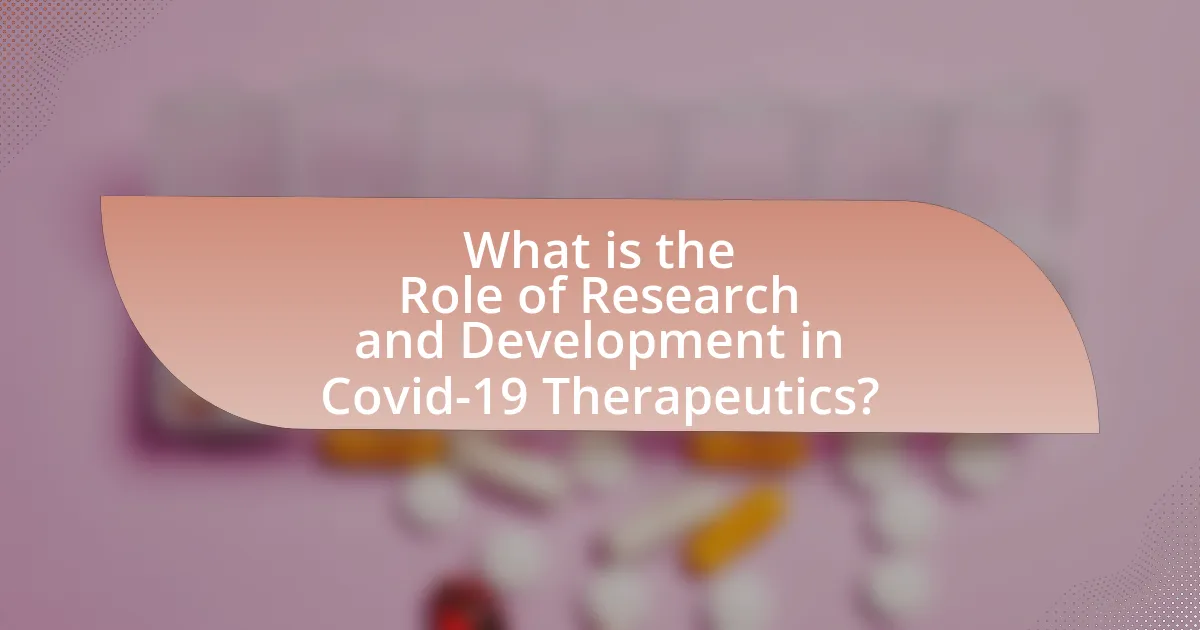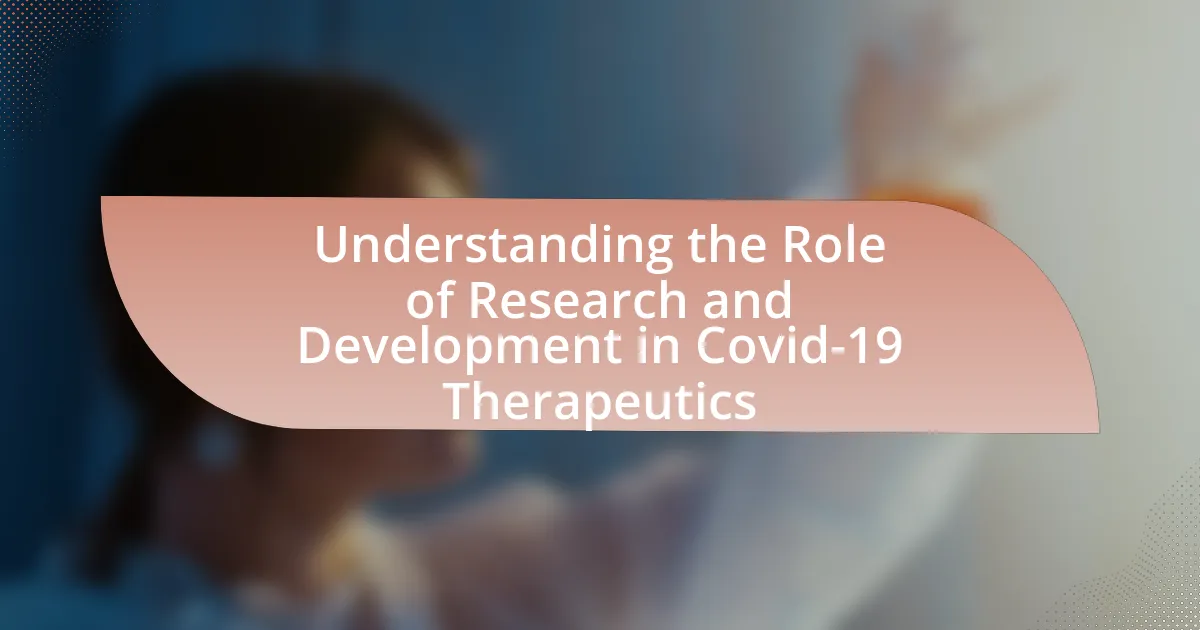Research and Development (R&D) is essential in the creation and optimization of Covid-19 therapeutics, facilitating the discovery of effective treatments and vaccines. The article outlines the evolution of R&D during the pandemic, highlighting key milestones such as the rapid development of antiviral drugs and monoclonal antibodies, as well as the unprecedented collaboration among pharmaceutical companies, academic institutions, and government bodies. It discusses the processes involved in R&D, including target identification, clinical trials, and regulatory approval, while also addressing the challenges faced in therapeutic development. Furthermore, the article explores future directions for R&D, emerging technologies, and best practices that have emerged from the Covid-19 response, emphasizing the importance of preparedness for future health crises.

What is the Role of Research and Development in Covid-19 Therapeutics?
Research and Development (R&D) plays a critical role in the creation and optimization of Covid-19 therapeutics by facilitating the discovery of effective treatments and vaccines. R&D efforts have led to the rapid identification of antiviral drugs, monoclonal antibodies, and other therapeutic agents that target the SARS-CoV-2 virus. For instance, the development of Remdesivir, an antiviral medication, was accelerated through R&D initiatives, demonstrating efficacy in reducing recovery time for hospitalized patients. Additionally, clinical trials conducted during the pandemic have provided essential data on the safety and effectiveness of various treatments, enabling regulatory agencies to authorize emergency use of therapeutics. The collaboration between pharmaceutical companies, academic institutions, and government bodies has further enhanced the speed and efficiency of R&D processes, resulting in the unprecedented development of multiple Covid-19 vaccines within a year, such as those by Pfizer-BioNTech and Moderna.
How has R&D evolved in response to the Covid-19 pandemic?
Research and Development (R&D) has evolved significantly in response to the Covid-19 pandemic by accelerating vaccine development and enhancing collaboration across sectors. The urgency of the pandemic led to the unprecedented use of mRNA technology, exemplified by the rapid development of the Pfizer-BioNTech and Moderna vaccines, which were created in less than a year, a process that typically takes a decade. Additionally, R&D efforts have increasingly focused on global collaboration, as seen in initiatives like the Coalition for Epidemic Preparedness Innovations (CEPI), which aims to fund and coordinate vaccine research. This evolution is supported by the fact that over 200 Covid-19 vaccines entered clinical trials within a year, showcasing a remarkable increase in the pace and scale of R&D activities compared to previous health crises.
What are the key milestones in Covid-19 therapeutic research?
Key milestones in Covid-19 therapeutic research include the rapid development of antiviral treatments, monoclonal antibodies, and the use of existing drugs. The first significant milestone was the identification of Remdesivir as a potential treatment, which received Emergency Use Authorization from the FDA in May 2020 after showing efficacy in reducing recovery time in hospitalized patients. Another milestone was the development of monoclonal antibodies, such as Bamlanivimab and Casirivimab/Imdevimab, which were authorized for emergency use in late 2020, demonstrating effectiveness in reducing viral load and preventing severe disease. Additionally, the repurposing of existing medications like Dexamethasone, which was shown to reduce mortality in severe cases, marked a critical advancement in treatment strategies. These milestones reflect the swift and adaptive nature of therapeutic research in response to the Covid-19 pandemic.
How did global collaboration impact R&D efforts?
Global collaboration significantly accelerated R&D efforts during the COVID-19 pandemic by facilitating the sharing of knowledge, resources, and technologies across borders. For instance, the collaboration between pharmaceutical companies, research institutions, and governments led to the rapid development of vaccines, such as the Pfizer-BioNTech and Moderna vaccines, which were developed in less than a year, a process that typically takes several years. This unprecedented speed was made possible by initiatives like the Coalition for Epidemic Preparedness Innovations (CEPI), which pooled funding and expertise from multiple countries to support vaccine research. Additionally, the sharing of clinical trial data and research findings through platforms like the World Health Organization’s COVID-19 database enabled researchers worldwide to build on each other’s work, further enhancing the efficiency and effectiveness of R&D efforts.
Why is R&D critical for developing Covid-19 therapeutics?
R&D is critical for developing Covid-19 therapeutics because it enables the discovery, testing, and optimization of effective treatments. Through rigorous research processes, scientists can identify potential drug candidates, understand their mechanisms of action, and evaluate their safety and efficacy in clinical trials. For instance, the rapid development of antiviral drugs like remdesivir and monoclonal antibodies was made possible by extensive R&D efforts, which included preclinical studies and accelerated clinical trials. These efforts have led to significant advancements in managing Covid-19, demonstrating the essential role of R&D in addressing public health crises.
What are the main challenges faced in Covid-19 therapeutic development?
The main challenges faced in Covid-19 therapeutic development include rapid virus mutation, regulatory hurdles, and the need for extensive clinical trials. Rapid mutation of the SARS-CoV-2 virus complicates the effectiveness of existing treatments and vaccines, as variants may evade immune responses. Regulatory hurdles arise from the need for expedited approval processes while ensuring safety and efficacy, which can delay access to therapies. Additionally, extensive clinical trials are necessary to establish the safety and effectiveness of new treatments, requiring significant time and resources, which can hinder timely responses to emerging health crises.
How does R&D contribute to the speed of therapeutic availability?
R&D accelerates the speed of therapeutic availability by streamlining the drug development process through innovative methodologies and technologies. For instance, the use of adaptive clinical trial designs allows for quicker adjustments based on interim results, thereby reducing the time needed for regulatory approval. Additionally, the implementation of advanced data analytics and artificial intelligence in R&D can identify promising compounds faster, leading to expedited preclinical and clinical testing phases. A notable example is the rapid development of COVID-19 vaccines, where R&D efforts utilized existing platforms and collaborative frameworks, resulting in emergency use authorizations within a year, a significant reduction compared to traditional timelines that can span over a decade.
What types of therapeutics have emerged from R&D efforts?
Various types of therapeutics have emerged from R&D efforts focused on COVID-19, including antiviral drugs, monoclonal antibodies, and vaccines. Antiviral drugs like remdesivir have been developed to inhibit viral replication, while monoclonal antibodies such as casirivimab and imdevimab target the virus directly to neutralize it. Additionally, multiple vaccines, including mRNA vaccines like Pfizer-BioNTech and Moderna, have been created to elicit an immune response against the virus. These developments are supported by extensive clinical trials and regulatory approvals, demonstrating their efficacy and safety in treating or preventing COVID-19.
What are the different categories of Covid-19 therapeutics?
The different categories of Covid-19 therapeutics include antiviral medications, monoclonal antibodies, corticosteroids, and supportive care treatments. Antiviral medications, such as remdesivir, target the virus directly to inhibit its replication. Monoclonal antibodies, like casirivimab and imdevimab, are designed to neutralize the virus and prevent severe disease. Corticosteroids, such as dexamethasone, reduce inflammation and have been shown to improve outcomes in severe cases. Supportive care treatments focus on managing symptoms and providing necessary medical support to patients. These categories reflect the diverse approaches taken in the research and development of effective Covid-19 treatments.
How do these therapeutics differ in mechanism and application?
Covid-19 therapeutics differ significantly in their mechanisms and applications. For instance, antiviral drugs like remdesivir inhibit viral replication by targeting the viral RNA polymerase, while monoclonal antibodies, such as casirivimab and imdevimab, neutralize the virus by binding to its spike protein, preventing it from entering human cells. Additionally, corticosteroids like dexamethasone reduce inflammation and modulate the immune response, which is crucial in severe cases of Covid-19. These differences in mechanisms lead to varied applications; antiviral drugs are primarily used for early treatment to reduce viral load, monoclonal antibodies are administered to high-risk patients to prevent severe disease, and corticosteroids are utilized in hospitalized patients experiencing severe respiratory distress.

What are the Processes Involved in R&D for Covid-19 Therapeutics?
The processes involved in R&D for Covid-19 therapeutics include target identification, preclinical testing, clinical trials, regulatory approval, and post-market surveillance. Target identification focuses on understanding the virus’s biology and identifying potential therapeutic targets, such as viral proteins. Preclinical testing involves laboratory and animal studies to evaluate the safety and efficacy of the therapeutic candidates. Clinical trials are conducted in phases to assess the drug’s safety, dosage, and effectiveness in humans, with Phase 1 focusing on safety, Phase 2 on efficacy, and Phase 3 on large-scale effectiveness. Regulatory approval is obtained from agencies like the FDA, which reviews the clinical trial data to ensure the therapeutic meets safety and efficacy standards. Finally, post-market surveillance monitors the therapeutic’s performance in the general population to identify any long-term effects or rare side effects. These processes are critical for developing safe and effective Covid-19 treatments, as evidenced by the rapid development and approval of therapies like remdesivir and monoclonal antibodies during the pandemic.
How is the research phase structured in developing Covid-19 therapeutics?
The research phase in developing Covid-19 therapeutics is structured into several key stages: discovery, preclinical testing, clinical trials, and regulatory review. During the discovery phase, researchers identify potential therapeutic targets and compounds through high-throughput screening and computational modeling. In the preclinical testing stage, selected candidates undergo laboratory and animal studies to evaluate their safety and efficacy. Following successful preclinical results, clinical trials are conducted in three phases, starting with small groups of healthy volunteers and progressing to larger populations to assess safety, dosage, and effectiveness. Finally, the regulatory review phase involves submitting data to health authorities, such as the FDA, for approval before the therapeutic can be made available to the public. This structured approach ensures thorough evaluation and validation of Covid-19 therapeutics, contributing to their effectiveness and safety in treating the disease.
What methodologies are commonly used in Covid-19 therapeutic research?
Common methodologies used in Covid-19 therapeutic research include randomized controlled trials (RCTs), observational studies, and in vitro experiments. RCTs are considered the gold standard for evaluating the efficacy of treatments, as they minimize bias and allow for direct comparisons between treatment groups. Observational studies provide real-world data on treatment outcomes and patient responses, while in vitro experiments help in understanding the mechanisms of action of potential therapeutics. These methodologies are essential for generating reliable evidence to inform clinical practice and public health decisions regarding Covid-19 treatments.
How do clinical trials fit into the R&D process?
Clinical trials are a critical phase in the research and development (R&D) process, specifically for evaluating the safety and efficacy of new therapeutics, including those for Covid-19. They follow preclinical studies and are designed to gather data on how a drug performs in humans, which is essential for regulatory approval. For instance, the clinical trials for Covid-19 vaccines, such as those conducted by Pfizer-BioNTech and Moderna, provided the necessary evidence of safety and effectiveness that led to Emergency Use Authorization by the FDA. This demonstrates that clinical trials are integral to transitioning from laboratory research to practical medical applications, ensuring that new treatments meet established safety standards before they are widely distributed.
What role does regulatory approval play in R&D for Covid-19 therapeutics?
Regulatory approval is crucial in the research and development of Covid-19 therapeutics as it ensures that treatments are safe, effective, and manufactured to high-quality standards. This approval process involves rigorous evaluation of clinical trial data by regulatory bodies such as the U.S. Food and Drug Administration (FDA) and the European Medicines Agency (EMA), which assess the therapeutic’s efficacy and safety profile before it can be made available to the public. For instance, the expedited approval pathways established during the pandemic, such as the FDA’s Emergency Use Authorization (EUA), allowed for quicker access to promising therapeutics while still maintaining essential safety and efficacy standards. This regulatory framework not only facilitates timely responses to public health emergencies but also fosters trust in the therapeutic options available to patients.
What are the key regulatory bodies involved in the approval process?
The key regulatory bodies involved in the approval process for Covid-19 therapeutics include the U.S. Food and Drug Administration (FDA), the European Medicines Agency (EMA), and the World Health Organization (WHO). The FDA is responsible for evaluating and approving drugs and vaccines in the United States, ensuring they meet safety and efficacy standards. The EMA performs similar functions in the European Union, providing scientific evaluation and supervision of medicines. The WHO plays a crucial role in coordinating international health responses and providing guidelines for the approval and use of therapeutics globally. These organizations collectively ensure that Covid-19 treatments are rigorously assessed before reaching the market.
How do expedited approval pathways affect therapeutic development?
Expedited approval pathways significantly accelerate therapeutic development by allowing faster access to market for promising treatments. These pathways, such as the FDA’s Emergency Use Authorization and Breakthrough Therapy Designation, enable developers to submit data for review earlier in the clinical trial process, thereby reducing the time from discovery to availability. For instance, during the COVID-19 pandemic, therapies like remdesivir received expedited approval, which facilitated timely treatment options for patients and demonstrated the effectiveness of rapid regulatory responses in addressing urgent public health needs.
How is funding allocated for R&D in Covid-19 therapeutics?
Funding for R&D in Covid-19 therapeutics is allocated through a combination of government grants, private investments, and public-private partnerships. For instance, the U.S. government allocated billions through initiatives like Operation Warp Speed, which provided funding to accelerate the development of vaccines and therapeutics. Additionally, pharmaceutical companies invest their own capital, often in collaboration with academic institutions and research organizations, to advance clinical trials and bring new treatments to market. This multi-faceted funding approach has led to rapid advancements in therapeutic options, evidenced by the swift development and approval of treatments such as monoclonal antibodies and antiviral drugs.
What sources of funding are available for Covid-19 therapeutic research?
Various sources of funding are available for Covid-19 therapeutic research, including government grants, private foundations, and pharmaceutical company investments. For instance, the U.S. National Institutes of Health (NIH) has allocated billions in funding specifically for Covid-19 research, while the Biomedical Advanced Research and Development Authority (BARDA) has provided substantial financial support for the development of therapeutics. Additionally, organizations like the Bill & Melinda Gates Foundation have committed significant resources to support global health initiatives related to Covid-19. These funding sources are critical for advancing research and development efforts aimed at combating the pandemic.
How do public-private partnerships influence funding dynamics?
Public-private partnerships (PPPs) significantly influence funding dynamics by leveraging resources and expertise from both sectors to enhance financial support for projects. These collaborations often result in increased investment in research and development, particularly in areas like Covid-19 therapeutics, where rapid innovation is crucial. For instance, during the pandemic, partnerships between governments and pharmaceutical companies facilitated substantial funding, exemplified by the Operation Warp Speed initiative in the United States, which allocated nearly $10 billion to accelerate vaccine development. This model not only mitigates financial risk for private entities but also ensures that public health priorities are addressed, thereby optimizing the allocation of resources and expediting the delivery of critical health solutions.

What are the Future Directions for R&D in Covid-19 Therapeutics?
Future directions for R&D in Covid-19 therapeutics include the development of novel antiviral agents, monoclonal antibodies, and combination therapies to enhance efficacy and reduce resistance. Research is increasingly focusing on targeting different stages of the viral lifecycle, with studies indicating that drugs like molnupiravir and nirmatrelvir/ritonavir show promise in clinical trials for reducing viral load and improving patient outcomes. Additionally, there is a growing emphasis on personalized medicine approaches, utilizing genetic and biomarker data to tailor treatments to individual patients, as evidenced by ongoing trials that assess the efficacy of therapeutics based on patient-specific factors. Furthermore, the integration of artificial intelligence in drug discovery is expected to accelerate the identification of potential therapeutic candidates, as highlighted by recent advancements in computational biology.
What emerging technologies are shaping the future of Covid-19 therapeutics?
Emerging technologies shaping the future of Covid-19 therapeutics include mRNA technology, monoclonal antibodies, and artificial intelligence. mRNA technology, exemplified by the Pfizer-BioNTech and Moderna vaccines, allows for rapid development and adaptability against variants. Monoclonal antibodies, such as those developed by Regeneron and Eli Lilly, provide targeted treatment options that can reduce severity and duration of illness. Artificial intelligence is being utilized to accelerate drug discovery and optimize clinical trials, enhancing the efficiency of therapeutic development. These technologies collectively represent a significant advancement in the fight against Covid-19, supported by extensive research and clinical trials demonstrating their efficacy and safety.
How might artificial intelligence impact therapeutic development?
Artificial intelligence (AI) can significantly enhance therapeutic development by accelerating drug discovery, optimizing clinical trials, and personalizing treatment options. AI algorithms analyze vast datasets to identify potential drug candidates more efficiently than traditional methods, reducing the time and cost associated with bringing new therapies to market. For instance, a study published in Nature Biotechnology demonstrated that AI could predict molecular interactions with up to 90% accuracy, streamlining the identification of promising compounds. Additionally, AI can improve patient recruitment for clinical trials by analyzing electronic health records to match suitable candidates, thereby increasing trial efficiency and success rates. Overall, AI’s ability to process and analyze complex data sets positions it as a transformative force in the development of therapeutics, particularly in response to urgent health crises like Covid-19.
What role do mRNA technologies play in future therapeutics?
mRNA technologies are poised to revolutionize future therapeutics by enabling rapid development of vaccines and treatments for various diseases. These technologies allow for the direct delivery of messenger RNA into cells, prompting them to produce specific proteins that can elicit an immune response or correct genetic deficiencies. For instance, the success of mRNA vaccines against COVID-19, such as those developed by Pfizer-BioNTech and Moderna, demonstrated their efficacy and speed in addressing emerging health threats. This platform can be adapted for other infectious diseases, cancer therapies, and genetic disorders, showcasing its versatility and potential for personalized medicine.
What lessons have been learned from R&D during the Covid-19 pandemic?
R&D during the Covid-19 pandemic has highlighted the importance of rapid innovation and collaboration in addressing public health crises. The accelerated development of vaccines, such as the Pfizer-BioNTech and Moderna mRNA vaccines, demonstrated that streamlined regulatory processes and public-private partnerships can significantly reduce the time from research to deployment. For instance, the Pfizer-BioNTech vaccine was developed and authorized for emergency use in under a year, a process that typically takes over a decade. Additionally, the pandemic underscored the necessity of global data sharing and transparency, as seen in the collaborative efforts of researchers and institutions worldwide to share genomic data of the virus, which facilitated the swift adaptation of vaccines to emerging variants. These lessons emphasize the need for preparedness, flexibility in research methodologies, and the establishment of frameworks that support rapid response to future health emergencies.
How can past experiences inform future pandemic preparedness?
Past experiences can inform future pandemic preparedness by providing critical insights into effective response strategies and resource allocation. Historical pandemics, such as the 1918 influenza and the recent COVID-19 outbreak, highlight the importance of rapid vaccine development, public health communication, and international collaboration. For instance, the swift development of mRNA vaccines during COVID-19, which took less than a year, was made possible by prior research on coronaviruses and vaccine technology. Additionally, lessons learned from the distribution challenges faced during the COVID-19 pandemic emphasize the need for robust supply chain management and equitable access to healthcare resources. These experiences underscore the necessity of investing in research and development, enhancing surveillance systems, and fostering global partnerships to effectively mitigate future pandemic threats.
What best practices have emerged from the Covid-19 R&D landscape?
Best practices that have emerged from the Covid-19 R&D landscape include accelerated collaboration among stakeholders, streamlined regulatory processes, and the use of adaptive trial designs. Accelerated collaboration has been exemplified by partnerships between pharmaceutical companies, governments, and research institutions, which facilitated rapid sharing of data and resources. For instance, the Coalition for Epidemic Preparedness Innovations (CEPI) played a crucial role in funding and coordinating vaccine development efforts globally. Streamlined regulatory processes were evident as agencies like the FDA and EMA implemented emergency use authorizations, allowing for quicker access to promising therapeutics and vaccines. Additionally, adaptive trial designs, such as the RECOVERY trial in the UK, allowed researchers to modify ongoing studies based on interim results, optimizing resource use and accelerating the identification of effective treatments. These practices have significantly enhanced the efficiency and effectiveness of R&D efforts in response to the pandemic.
What practical steps can researchers take to enhance R&D efforts in Covid-19 therapeutics?
Researchers can enhance R&D efforts in Covid-19 therapeutics by fostering collaboration across disciplines, increasing funding for innovative projects, and utilizing advanced technologies such as artificial intelligence for drug discovery. Collaborative efforts, such as partnerships between academic institutions and pharmaceutical companies, can accelerate the sharing of data and resources, leading to faster development timelines. Increased funding, as evidenced by government initiatives like Operation Warp Speed, has proven effective in supporting rapid research and development. Additionally, employing AI and machine learning can streamline the identification of potential therapeutic candidates, as demonstrated by their successful application in analyzing vast datasets to predict drug interactions and efficacy.


